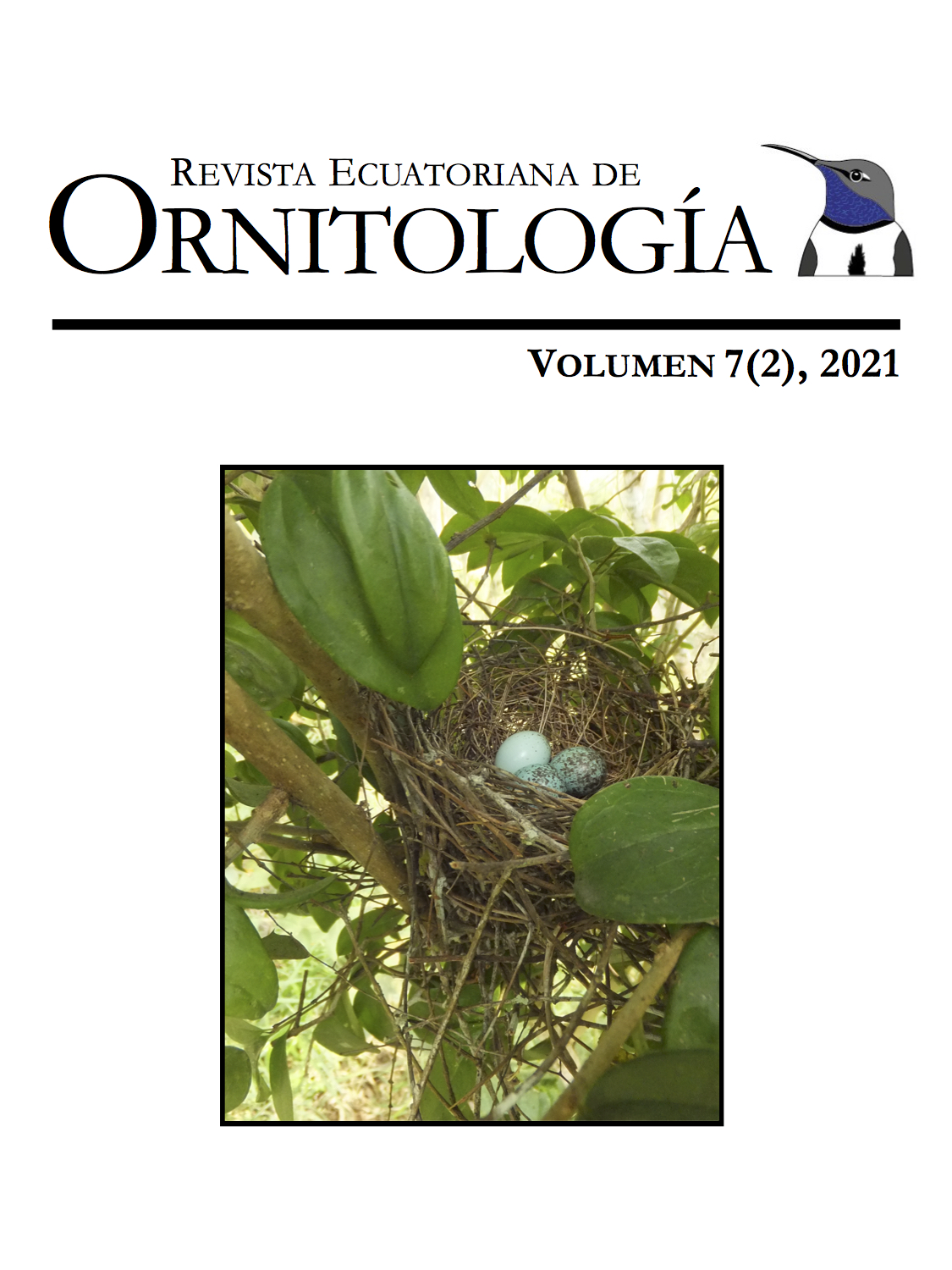OBSERVATIONS ON THE NEST OF BROWN-BELLIED SWALLOW Orochelidon murina (HIRUNDINIDAE) IN QUITO
DOI:
https://doi.org/10.18272/reo.v7i2.1993Keywords:
Adulto extra, cuidado parental, estructuras artificiales, Golondrina Ventricafé, nido, Orochelidon murina, polluelos.Abstract
I present observations on the nest, nestlings and parental care of the Brown-bellied Swallow Orochelidon murina in La Armenia, 7 km southeast of Quito, province of Pichincha, Ecuador. I observed the nest from 26 April-21 May 2020, every other day for 1.5-2 h, with a total of 20 h of observation. The nest was located in a drainpipe at 2.15 m above ground, in a wall surrounding a residence. The drainpipe had a diameter of 10 cm and a depth of 25 cm. The nest, which covered the drainpipe"™s entire length, consisted of a shallow mound of vegetal fibers, feathers and feces of the nest dweller. Clutch size was three and nestling period at least 25 days. Nestlings were fed on average 8 times/h (SD = 3.4; n = 11) over the observation period.The overall mean interval between visits was 5.3 min (SD = 5.4; n = 106) and mean visit time 0.3 min (SD = 0.9; n = 103). A third adult was observed around the nest on several occasions, but no active role in nestlings"™ care could be determined.
Downloads
References
Benítez-Saldívar, M.J., & Massoni, V. (2017). Song structure and song repertoires of the Saffron Finch (Sicalis flaveola pelzelni) breeding in Argentinian pampas. Bioacoustics, 27(4), 327-340. DOI: https://doi.org/10.1080/09524622.2017.1344932
Buitrón, G., & Freile, J.F. (2006). Registros inusuales de aves migratorias y de bosques subtropicales en Quito, Ecuador. Cotinga, 26, 54-56. URL: https://www.neotropicalbirdclub.org/wp-content/uploads/2016/12/C26-Quito.pdf
Cisneros-Heredia. D.F., Amigo, X., Arias, D., Arteaga, J., Bedoya, J., Espinosa, S., Montenegro, E., Nazati, G., & Carrión, J.M. (2015). Reporte del 1er conteo navideño de aves de Quito, Ecuador. Revista Avances en Ciencias e Ingenierías, 7(2), B37-B51. DOI: https://doi.org/10.18272/aci.v7i2.256
Collins, C. (2010). Growth and development of the Blue-and-white Swallow in Venezuela. Living World, 2010, 59-63. URL: https://ttfnc.org/livingworld/index.php/lwj/article/view/collins2010
Fjeldså, J., & Krabbe, N. (1990). Birds of the high Andes. Svendborg & Copenhagen, Denmark: University of Copenhagen & Apollo Books.
Freile, J., & Restall, R. (2018). Birds of Ecuador. London, UK: Helm Field Guides.
Greeney, H.F., Martin, P., Gelis, R.A., Solano-Ugalde, A., Bonier, F., Freeman, B., & Miller, E. (2011). Notes on the breeding of high-Andean birds in Northern Ecuador. Bulletin of the British Ornithologists"™ Club, 131(1), 24-31. URL: https://www.biodiversitylibrary.org/part/272494
Kiff, L., Marín, M.A., Sibley, F.C., Matheus, J.C., & Schmitt, N. (1989). Notes on the eggs and nests of some Ecuadorian Birds. Bulletin of the British Ornithologists"™ Club, 109(1), 25-31. URL: https://www.biodiversitylibrary.org/page/40026898#page/33/mode/1up
Linck, E., Huber, H., Greeney, H.F., & Sheldon, K. (2019). Nesting biology of the Blue-and-white Swallow (Pygochelidon cyanoleuca) in northeastern Ecuador. Ornitología Neotropical, 30(1), 5-10. URL: https://journals.sfu.ca/ornneo/index.php/ornneo/article/view/402
Lombardo, P. (1986). Attendants at Tree Swallow nests. 1. Are attendants helpers at the nest? Condor, 88(3), 768-778. DOI: https://doi.org/10.2307/1368876
Massoni, V., Bulit, F., & Reboreda, J.C. (2007). Breeding biology of the White-rumped Swallow, Tachycineta leucorrhoa, in Buenos Aires Province, Argentina. Ibis, 149(1), 10-17. DOI: https://doi.org/10.1111/j.1474-919X.2006.00589.x
McCarty, J. (2002). The number of visits to the nest by parents is an accurate measure of food delivered to nestlings in Tree Swallows. Journal of Field Ornithology, 73(1), 9-14. URL: https://www.jstor.org/stable/4131060?seq=1
Medvin, M., Beecher, M., & Andelman, S. (1987). Extra adults at the nest in Barn Swallows. Condor, 89(1), 179-182. DOI: https://doi.org/ 10.2307/1368774
Michaud, T., & Leonard, M. (2000). The role of development, parental behavior, and nestmate competition in fledging of nestling Tree Swallows. Auk, 117(4), 996-1002. DOI: https://doi.org/10.1093/auk/117.4.996
Moore, I., Wingfield, J., & Brenowitza, E. (2004). Plasticity of the avian song control system in response to localized environmental cues in an equatorial songbird. Journal of Neuroscience, 24(45), 10182-10185. URL: https://www.jneurosci.org/content/jneuro/24/45/10182.full.pdf
Moreau, R., & Moreau, W. (1939). Observations of swallows and House-Martins at the nest. British Birds, 33(6), 146-151. URL: https://britishbirds.co.uk/volume-33/issue-6
Shogren, E. (2020). Andean Swallow (Orochelidon andecola), version 1.0. In T.S. Schulenberg (Ed), Birds of the World. Ithaca, NY: Cornell Lab of Ornithology. DOI: https://doi.org/10.2173/bow.andswa2.01
Skutch, A. (1935). Helpers at the nest. Auk, 52(3), 257-273. DOI: https://doi.org/10.2307/4077738
Turner, A. (2020). Brown-bellied Swallow (Orochelidon murina), version 1.0. In J. del Hoyo, A. Elliott, J. Sargatal, D.A. Christie, & E. de Juana (Eds), Birds of the Word. Ithaca, NY: Cornell Lab of Ornithology. DOI: https://doi.org/10.2173/bow.brbswa1.01
Downloads
Published
How to Cite
Issue
Section
License
Los autores que publiquen en la Revista Ecuatoriana de Ornitología aceptan los siguientes términos:
- Los autores/as conservarán sus derechos de autor y garantizarán a la revista el derecho de primera publicación de su obra, el cuál estará simultáneamente sujeto a la Licencia de Reconocimiento No Comercial de Creative Commons.
- Los autores/as podrán adoptar otros acuerdos de licencia no exclusiva de distribución de la versión de la obra publicada, pudiendo de esa forma publicarla en un volumen monográfico o reproducirla de otras formas, siempre que se indique la publicación inicial en esta revista.
- Se permite y se recomienda a los autores difundir su obra a través de Internet en su repositorio institucional, página web personal, o red social científica (como ResearchGate o Academia.edu).


